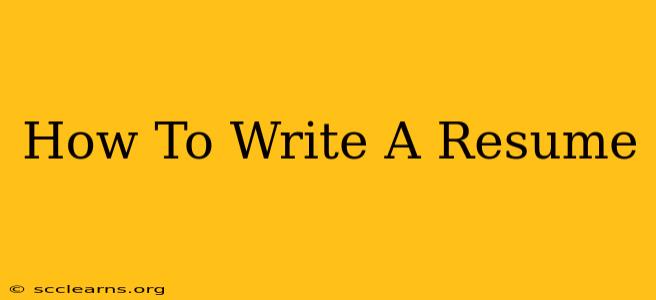Landing your dream job starts with a compelling resume. This guide will walk you through crafting a resume that not only showcases your skills and experience but also grabs the attention of recruiters and hiring managers. We'll cover everything from choosing the right format to highlighting your accomplishments effectively.
Choosing the Right Resume Format
The format of your resume is crucial. Three main formats exist: chronological, functional, and combination.
1. Chronological Resume:
This is the most common format, listing your work experience in reverse chronological order (most recent first). It's ideal if you have a consistent work history and want to emphasize your career progression.
Strengths: Simple, easy to read, highlights career progression. Weaknesses: Doesn't highlight skills as effectively if you have gaps in your employment history or have frequently changed careers.
2. Functional Resume:
This format emphasizes your skills and abilities rather than your work history. It's best if you have gaps in your employment history, are changing careers, or have limited work experience.
Strengths: Highlights skills, ideal for career changers. Weaknesses: Can raise red flags with some recruiters who may see it as hiding employment gaps.
3. Combination Resume:
This format combines elements of both chronological and functional resumes. It highlights your skills upfront while still providing a chronological work history. It's a versatile option that works well for many job seekers.
Strengths: Balances skills and experience, versatile. Weaknesses: Can be slightly longer than other formats.
Crafting Compelling Content: Keywords and Action Verbs
Your resume isn't just a list of jobs; it's a marketing document showcasing your value. Use strong action verbs and relevant keywords.
Powerful Action Verbs:
Instead of saying "Responsible for...", use more active verbs like:
- Managed: Managed a team of 10, overseeing all aspects of project delivery.
- Developed: Developed and implemented a new marketing strategy that increased sales by 15%.
- Increased: Increased customer satisfaction scores by 20% through improved customer service training.
- Led: Led a cross-functional team to successfully launch a new product.
- Improved: Improved operational efficiency by 10% through process optimization.
Keywords:
Research the job description thoroughly and identify keywords related to the skills and experience required. Incorporate these keywords naturally throughout your resume. Don't just stuff keywords; use them to accurately reflect your experience.
Essential Resume Sections:
A well-structured resume typically includes these sections:
1. Contact Information:
- Name: Use a professional font and size.
- Phone Number: Provide a reliable phone number.
- Email Address: Use a professional email address.
- LinkedIn Profile URL (Optional): Include if your profile is up-to-date and relevant.
2. Summary/Objective Statement (Optional):
A brief summary highlighting your key skills and career goals. An objective statement is more focused on a specific job.
3. Skills Section:
List your hard skills (technical abilities) and soft skills (interpersonal abilities). Categorize them for better readability.
4. Work Experience:
For each role, use the PAR (Problem-Action-Result) method to describe your accomplishments. Quantify your achievements whenever possible.
5. Education:
List your degrees, certifications, and relevant coursework.
6. Awards and Recognition (Optional):
Include any awards or recognition you've received.
Proofreading and Formatting:
Before submitting your resume, meticulously proofread it for any grammatical errors or typos. Use a professional font and ensure consistent formatting throughout.
Optimizing Your Resume for Applicant Tracking Systems (ATS):
Many companies use Applicant Tracking Systems (ATS) to screen resumes. To ensure your resume is ATS-friendly:
- Use a simple format: Avoid complex tables or graphics.
- Save as a PDF or Word document: PDFs preserve formatting, while Word documents are also widely compatible.
- Use keywords strategically: Incorporate relevant keywords throughout your resume.
By following these tips, you'll create a resume that effectively showcases your qualifications and helps you land interviews. Remember to tailor your resume to each job application to maximize your chances of success. Good luck!

